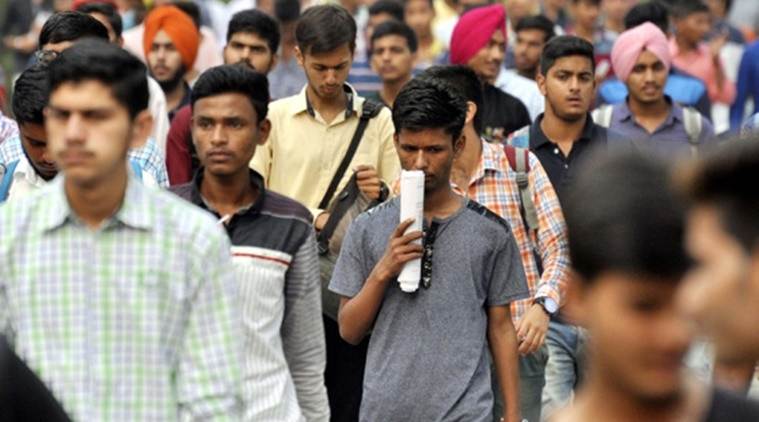Dharwad witnessed a massive protest by job aspirants, bringing normal life to a standstill in the city. Thousands of unemployed youth took to the streets, demanding immediate government intervention to address long-standing employment issues. Traffic came to a halt, government offices faced disruptions, and local businesses reported operational difficulties as protesters blocked key thoroughfares. The demonstration highlighted the frustrations of the youth, who have been waiting for recruitment drives and timely notifications for government and public sector job vacancies.
Protesters voiced grievances over delays in recruitment processes, alleged irregularities in previous selection rounds, and a lack of transparency in government hiring. Many claimed that promises made by authorities remained unfulfilled, forcing them to take to the streets. Organizers emphasized that the protest was peaceful, aiming to draw attention to the plight of job seekers rather than creating violence. Authorities, however, deployed police forces to manage crowds and maintain law and order, ensuring that the demonstration did not escalate into chaos.
The protest also attracted attention from local media and political figures, who highlighted the socio-economic challenges facing unemployed youth. Experts note that high unemployment can lead to frustration, mental stress, and social unrest, particularly when aspirants perceive systemic inefficiencies. The Dharwad protest serves as a stark reminder of the pressing need for timely recruitment and effective policy measures to support youth employment in Karnataka.
Legal and administrative experts note that such protests underscore gaps in communication between authorities and citizens. Timely announcements, regular updates, and accessible online portals could mitigate frustrations and reduce the likelihood of mass mobilizations. Many argue that structured grievance redressal systems and stakeholder consultations before recruitment delays become public issues would strengthen public trust in government processes and enhance civic engagement.
The protest has broader socio-economic implications. Prolonged unemployment can lead to mental stress, anxiety, and social frustration among youth, potentially contributing to unrest or declining productivity. Economists point out that creating timely employment opportunities and improving recruitment efficiency are critical to preventing long-term social and economic costs. Dharwad’s protest serves as a stark reminder that administrative delays can escalate into civic action, with significant societal impact.
Authorities have indicated that dialogue with aspirants will begin soon, focusing on clarifying pending recruitment schedules and resolving procedural bottlenecks. Officials stressed that while public demonstrations are allowed under constitutional rights, collaboration with authorities is essential for achieving concrete solutions. Aspirants, for their part, have pledged to continue peaceful protests while remaining open to negotiation, signaling a readiness to cooperate if tangible steps are taken promptly.
The protest has also caught the attention of political parties and civic organizations, who have urged authorities to act decisively. Several leaders emphasized the importance of transparent processes and the need to restore faith in public recruitment mechanisms. Calls for reforms include better coordination between state and district recruitment offices, digitization of application tracking, and stricter adherence to promised timelines, reflecting widespread recognition that systemic improvements are needed.
Analysts highlight that youth protests such as Dharwad’s are part of a broader national pattern. Across India, educated aspirants increasingly resort to public demonstrations to demand timely and fair employment opportunities. The Dharwad event is emblematic of this trend, demonstrating both the determination of the youth and the consequences of delayed governance. It reinforces the need for proactive policy interventions to address employment concerns before unrest escalates.
Psychologists emphasize the emotional toll on aspirants participating in prolonged protests. Continuous uncertainty over job prospects, compounded by delayed recruitment processes, contributes to stress, anxiety, and social strain. Public demonstrations provide a collective outlet for expressing grievances, yet they also underline the urgency for authorities to implement solutions that restore hope, stability, and trust in public institutions.
Economic observers suggest that addressing the demands of Dharwad’s aspirants could have positive downstream effects. Prompt recruitment and transparent processes would not only relieve individual stress but also enhance productivity and consumer confidence. Ensuring timely employment could stimulate local economies, increase household income, and foster social stability, highlighting the interconnectedness of governance, employment, and economic well-being.
Finally, the Dharwad job aspirants’ protest underscores a fundamental lesson: citizen engagement, when channeled peacefully, can compel authorities to act and prioritize public welfare. While the protest temporarily disrupted life in the city, it succeeded in drawing attention to the pressing issue of unemployment, prompting both administrative and policy responses. The event reflects the power of collective civic action in shaping governance, emphasizing the need for timely, transparent, and equitable solutions to employment challenges in Karnataka.
Aspirants’ Demands
The primary demands of the protesters included immediate commencement of pending recruitment processes, transparency in selection procedures, and clarification on age and eligibility criteria. They also called for more frequent government job notifications to ensure equal opportunity for aspirants. Youth leaders emphasized that prolonged delays and lack of communication had created uncertainty, pushing them to organize large-scale demonstrations.
Authorities acknowledged the protesters’ concerns and assured them of dialogue in the coming days. Officials stated that recruitment timelines and verification processes are being reviewed to prevent delays. While maintaining that law and order must be preserved, authorities expressed willingness to consider aspirants’ demands, emphasizing the government’s commitment to providing fair and timely employment opportunities.
The massive protest by job aspirants in Dharwad reflects deep-rooted frustrations over employment delays and perceived systemic inefficiencies. Thousands of youth from across the district congregated in key city areas, voicing their grievances through slogans, marches, and demonstrations. Their actions disrupted normal traffic flow, delayed public transport, and temporarily halted operations in government offices, highlighting the scale of discontent among educated unemployed citizens. Observers note that such large-scale mobilizations signal both desperation and determination, emphasizing the urgent need for government intervention in the recruitment process.
Many aspirants highlighted repeated delays in government job notifications and recruitment examinations as a primary cause of frustration. Promises made in the past regarding recruitment schedules and provisional results have often not materialized, leading to a sense of disillusionment. Youth leaders expressed concern over age-limit issues, lack of clarity in eligibility criteria, and insufficient communication from authorities. These procedural ambiguities have exacerbated anxiety among aspirants, creating a fertile ground for organized protests demanding immediate resolution.

Authorities in Dharwad acknowledged the scale of the protest and the legitimacy of many of the aspirants’ concerns. Police and municipal teams were deployed to ensure that demonstrations remained peaceful and to manage traffic and public safety. Additional law enforcement personnel were tasked with monitoring assembly points, controlling crowd movement, and preventing potential confrontations with bystanders or motorists. While the authorities emphasized law and order, they also recognized the need to engage with the aspirants through dialogue.
Local businesses reported operational disruptions as the protests blocked commercial areas and main thoroughfares. Shops, banks, and offices in central Dharwad faced reduced customer inflow, leading to temporary revenue losses. Employees were forced to take alternate routes, while students struggled to reach educational institutions on time. Despite the inconvenience, many residents expressed sympathy with the protestors’ cause, understanding that the demonstration reflected broader socio-economic issues affecting youth employment in the region.
Social media played a pivotal role in amplifying the protest’s impact. Videos of large gatherings, slogans, and roadblocks circulated widely across platforms, drawing attention from citizens and policymakers alike. Hashtags and posts highlighting aspirants’ grievances garnered significant engagement, generating public discourse on government accountability and employment challenges. This digital visibility increased pressure on authorities to address the issues swiftly, demonstrating the growing influence of social media in shaping public policy debates.
The aspirants’ demands were clear and focused. They called for immediate commencement of pending recruitment processes, transparent verification of candidate applications, and prompt release of examination schedules. Protests also emphasized equitable treatment in eligibility and age criteria, along with assurance of fair selection mechanisms. Youth leaders highlighted that prolonged delays and uncertainty had created undue stress, urging authorities to introduce mechanisms that ensure timeliness and transparency in future recruitment exercises.
Impact on Daily Life
The protest disrupted normal life in Dharwad significantly. Public transportation faced delays, students struggled to reach educational institutions, and businesses reported revenue losses due to blocked roads. Residents expressed both sympathy and frustration, understanding the aspirants’ plight while being inconvenienced by the massive mobilization. The city administration deployed additional traffic personnel and coordinated with police forces to manage congestion and ensure emergency services remained operational.
Social media coverage amplified the scale of the protest, with videos and images of large gatherings circulating widely. Citizens expressed solidarity with the aspirants while urging authorities to expedite solutions. Political parties also weighed in, using the protest to demand systemic reforms in recruitment processes, while advocating for policies to create more employment opportunities across the state.
Experts note that prolonged unemployment among educated youth can have broader socio-economic consequences. Delays in recruitment and lack of transparency contribute to disillusionment, eroding trust in government institutions. The Dharwad protest has reignited discussions on the need for streamlined processes, digital recruitment portals, and timely notification mechanisms to mitigate such tensions in the future.

While the protest caused temporary disruption, it underscores the seriousness of unemployment issues in Karnataka. Authorities have reiterated their commitment to addressing the grievances, while aspirants have promised to maintain peaceful demonstrations until concrete steps are taken. The Dharwad protest serves as both a wake-up call for policymakers and a demonstration of youth mobilization around employment concerns.
The youth leaders coordinating the protest emphasized that dialogue with officials is crucial for achieving resolution. They urged authorities to consider interim measures, such as provisional notifications and accelerated verification, to provide relief to aspirants. Such interventions could help rebuild trust while ensuring that the recruitment process remains fair, transparent, and efficient.
Follow: Karnataka Government
Also read: Home | Channel 6 Network – Latest News, Breaking Updates: Politics, Business, Tech & More

